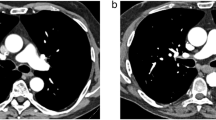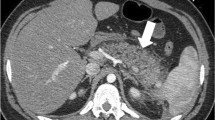Abstract
Purpose
The purpose of this study is to assess the dose of ionizing radiation caused by repeated CT scans performed to investigate non-traumatic acute abdominal conditions in young adults.
Methods
Over 26 months, we collected a cohort of patients aged 18 to 45 years who were subject to at least one urgent contrast-enhanced abdomen/pelvis CT. Patients affected with urolithiasis, HIV infection, tumors, and vascular and chronic inflammatory bowel diseases were excluded. All abdomen/pelvis CT scans carried out at our institution for over 6 years were retrospectively tallied, and the effective doses (EDs) were computed by multiplying the total dose-length product by the appropriate anatomic conversion factor. Examples of age- and gender-adjusted lifetime attributable cancer risks were estimated using the online calculator Radiation Risk Assessment Tool.
Results
Sixty-one patients (average age 34.2 years) received multiple CT scans (average 2.7 scans per patient). ED largely varied among single- and multi-phase acquisitions. Cumulative ED ranged from 14.1 mSv to a maximum of 436.6 mSv (average 70.1 mSv per person). Twenty-five patients (40.9%) received more than 50 mSv, 84% of them within year; 12 (19.7%) and 4 (6.6%) patients received more than 100 and 200 mSv, respectively.
Conclusion
Young adults are subject to repetitive CT imaging to monitor urogenital, intestinal, hepatobiliary, and pancreatic disorders during non-operative management to detect and follow up abdominal emergencies requiring surgical intervention and to assess post-surgical complications. In this population, the risk of accruing high cumulative radiation exposure should be considered.



Similar content being viewed by others
References
Cartwright SL, Knudson MP (2015) Diagnostic imaging of acute abdominal pain in adults. Am Fam Physician 91:452–459
Chin JY, Goldstraw E, Lunniss PJ et al (2012) Evaluation of the utility of abdominal CT scans in the diagnosis, management, outcome and information given at discharge of patients with non-traumatic acute abdominal pain. BJR 85:e596–e602
Gangadhar K, Kielar A, Dighe MK et al (2016) Multimodality approach for imaging of nontraumatic acute abdominal emergencies. Abdom Radiol (NY) 41:136–148
Rosen MP, Siewert B, Sands DZ et al (2003) Value of abdominal CT in the emergency department for patients with abdominal pain. Eur Radiol 13:418–424
Stoker J, van Randen A, Lameris W et al (2009) Imaging patients with acute abdominal pain. Radiology 253:31–46
van Randen A, Lameris W, Van Es W et al (2011) A comparison of the accuracy of ultrasound and computed tomography in common diagnoses causing acute abdominal pain. Eur Radiol 21:1535–1545
Brenner DJ, Doll R, Goodehead DT et al (2003) Cancer risks attributable to low doses of ionizing radiation: assessing what we really know. Proc Natl Acad Sci U S A 100:13761–13766
Brenner DJ, Hall EJ (2007) Computed tomography—an increasing source of radiation exposure. N Engl J Med 357:2277–2284
Cardis E, Vrijheid M, Blettner M et al (2005) Risk of cancer after low doses of ionising radiation: retrospective cohort study in 15 countries. BMJ 331:77
Griffey RT, Sodickson A (2009) Cumulative radiation exposure and cancer risk estimates in emergency department patients undergoing repeat or multiple CT. AJR Am J Roentgenol 192:887–892
Hendee WR, O’Connor MK (2012) Radiation risks of medical imaging: separating facts from fantasy. Radiology 264:312–321
Shah KH, Slovis BH, Runde D et al (2013) Radiation exposure among patients with the highest CT scan utilization in the emergency department. Emerg Radiol 20:485–491
Worrall JC, Jama S, Stiell IG (2014) Radiation doses to emergency department patients undergoing computed tomography. CJEM 16:477–484
Kalra MK, Maher MM, Toth TL et al (2004) Strategies for CT radiation dose optimization. Radiology 230:619–628
Sensakovic WF, Warden DR (2016) What is the CT dose report sheet and why is it useful? AJR Am J Roentgenol 207:929–930
Bongartz G European guidelines on quality criteria for computed tomography (EUR 16262)
National Research Council (NRC) Committee to Assess Health Risks from Exposure to Low Levels of Ionizing Radiation. (2005) Health risks from exposure to low levels of ionizing radiation: BEIR VII Phase 2. National Academy of Sciences; Washington, DC Available at: “http://nap.edu/11340.: Accessed Jan 30, 2017
Durand DJ (2011) A rational approach to the clinical use of cumulative effective dose estimates. AJR Am J Roentgenol 197:160–162
Griffey RT, Jeffe DB, Bailey T (2014) Emergency physicians’ attitudes and preferences regarding computed tomography, radiation exposure, and imaging decision support. Acad Emerg Med 21:768–777
Pines JM (2009) Trends in the rates of radiography use and important diagnoses in emergency department patients with abdominal pain. Med Care 47:782–786
Berrington de Gonzalez A, Iulian Apostoaei A, Veiga LH et al (2012) RadRAT: a radiation risk assessment tool for lifetime cancer risk projection. J Radiol Prot 32:205–222
Gunalp M, Gulunay B, Polat O et al (2014) Ionising radiation awareness among resident doctors, interns, and radiographers in a university hospital emergency department. Radiol Med 119:440–447
Sheu Y, Furlan A, Almusa O et al (2012) The revised Atlanta classification for acute pancreatitis: a CT imaging guide for radiologists. Emerg Radiol 19:237–243
Zaheer A, Singh VK, Qureshi RO et al (2013) The revised Atlanta classification for acute pancreatitis: updates in imaging terminology and guidelines. Abdom Imaging 38:125–136
Ball CG, Correa-Gallego C, Howard TJ et al (2010) Radiation dose from computed tomography in patients with necrotizing pancreatitis: how much is too much ? J Gastrointest Surg 14:1529–1535
Morgan DE, Ragheb CM, Lockhart ME et al (2010) Acute pancreatitis: computed tomography utilization and radiation exposure are related to severity but not patient age. Clin Gastroenterol Hepatol 8:303–308
Tonolini M, Villa F, Ippolito S et al (2015) Pictorial review of normal postoperative cross-sectional imaging findings and infectious complications following laparoscopic appendectomy. Insights Imaging 6:65–72
Nau P, Molina G, Shima A et al (2015) Roux-en-Y gastric bypass is associated with an increased exposure to ionizing radiation. Surg Obes Relat Dis 11:308–312
Oei TN, Shyn PB, Govindarajulu U et al (2010) Diagnostic medical radiation dose in patients after laparoscopic bariatric surgery. Obes Surg 20:569–573
Ditkofsky NG, Singh A, Avery L et al (2014) The role of emergency MRI in the setting of acute abdominal pain. Emerg Radiol 21:615–624
Singh A, Danrad R, Hahn PF et al (2007) MR imaging of the acute abdomen and pelvis: acute appendicitis and beyond. Radiographics 27:1419–1431
Tkacz JN, Anderson SA, Soto J (2009) MR imaging in gastrointestinal emergencies. Radiographics 29:1767–1780
Tonolini M, Ravelli A, Villa C et al (2012) Urgent MRI with MR cholangiopancreatography (MRCP) of acute cholecystitis and related complications: diagnostic role and spectrum of imaging findings. Emerg Radiol 19:341–348
De Pascale A, Piccoli GB, Priola SM et al (2013) Diffusion-weighted magnetic resonance imaging: new perspectives in the diagnostic pathway of non-complicated acute pyelonephritis. Eur Radiol 23:3077–3086
de Freitas TF, Schraibman V, Ardengh JC et al (2015) Diffusion-weighted magnetic resonance imaging indicates the severity of acute pancreatitis. Abdom Imaging 40:265–271
Lee NK, Kim S, Kim DU et al (2015) Diffusion-weighted magnetic resonance imaging for non-neoplastic conditions in the hepatobiliary and pancreatic regions: pearls and potential pitfalls in imaging interpretation. Abdom Imaging 40:643–662
Author information
Authors and Affiliations
Corresponding author
Ethics declarations
Conflict of interest
The authors declare that they have no conflict of interest.
Rights and permissions
About this article
Cite this article
Tonolini, M., Valconi, E., Vanzulli, A. et al. Radiation overexposure from repeated CT scans in young adults with acute abdominal pain. Emerg Radiol 25, 21–27 (2018). https://doi.org/10.1007/s10140-017-1554-y
Received:
Accepted:
Published:
Issue Date:
DOI: https://doi.org/10.1007/s10140-017-1554-y




